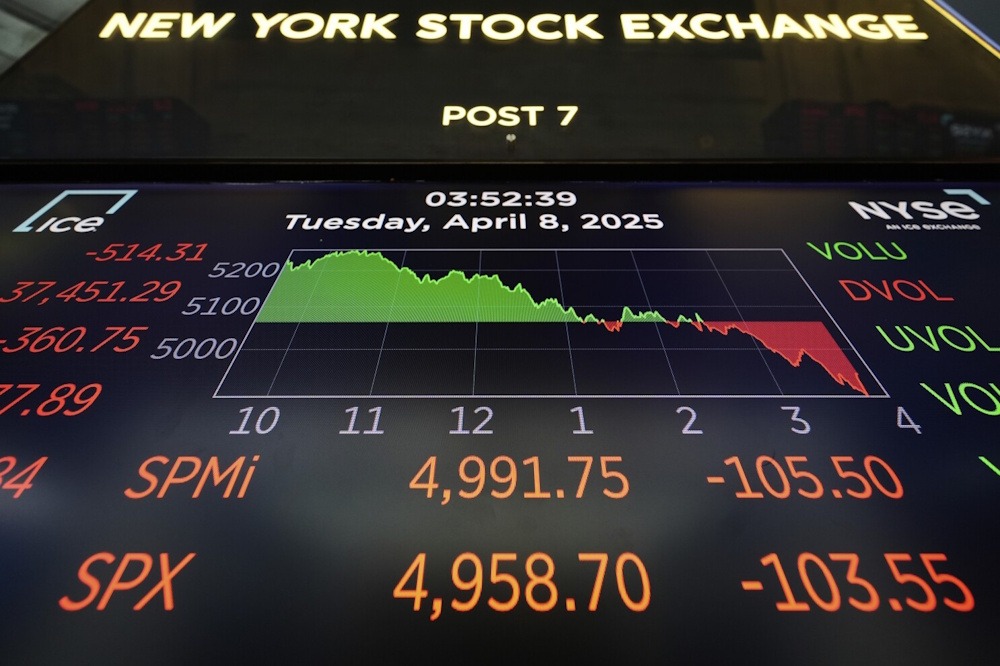
Dow futures are experiencing a slight decline, as focus remains on Congressional lawmakers engaged in a contentious policy dispute just hours ahead of a potential federal government shutdown. A meeting involving leaders from both the Republican and Democratic parties, along with President Donald Trump, does not yield any significant progress, exacerbating an already uncertain economic outlook. This situation has contributed to a surge in gold prices reaching new record highs, alongside concerns regarding potential delays in the release of crucial economic data. In other developments, Trump has declared a new set of tariffs, while athletic apparel company Nike is set to release its most recent financial results.
Dow futures indicated a downward trend on Tuesday, as investors evaluated the possible consequences of a federal government shutdown. As of 03:33, the Dow futures contract experienced a decrease of 79 points, representing a decline of 0.2%. Meanwhile, S&P 500 futures fell by 10 points, equivalent to a 0.1% drop, and Nasdaq 100 futures saw a reduction of 37 points, also reflecting a 0.1% decrease. The primary indices experienced an uptick on Monday, supported in part by a slight increase in U.S. Treasuries. Yields, which typically exhibit an inverse relationship with prices, decreased by 1 to 3 basis points across the curve. Expectations that the Federal Reserve will persist in reducing interest rates this year, alongside heightened optimism regarding artificial intelligence, provided a boost to stocks and mitigated some concerns surrounding the policy impasse in Washington. In individual stocks, chip gear maker Lam Research experienced a notable increase following a rating upgrade by Deutsche Bank, while AppLovin surged to an all-time high after Morgan Stanley revised its outlook for the company.
The deadline looms for U.S. lawmakers to enact a short-term funding bill, as failure to reach an agreement will result in a government shutdown. A spending bill supported by Republicans has successfully passed through the House of Representatives; however, it now encounters opposition in the Senate. With a 53-seat majority in the Senate, Republicans face the necessity of securing a minimum of 60 votes to pass the spending bill. Leaders from both the Republican and Democratic parties attributed the stalemate in negotiations to one another after a meeting with President Donald Trump on Monday. Republicans have charged their counterparts with taking the government “hostage,” whereas Democrats, who have been insisting on an extension of health care subsidies as a condition for their backing of a funding bill, cautioned that failing to meet this demand could jeopardize health coverage for millions of Americans. Following the assembly, Vice President JD Vance expressed his belief that the government is “headed to a shutdown.” Analysts have indicated that the closure of the government may postpone the release of the critical nonfarm payrolls data, set to be disclosed on Friday. Markets will have the opportunity to analyze new labor market data later today, as a measure of job openings — an indicator of hiring demand — is set to be released.
Gold prices have reached new record highs, continuing their robust performance over the past week as market participants expressed concerns regarding a potential U.S. government shutdown. Such events may pose a risk to economic activity within the country, potentially jeopardizing growth prospects. Ongoing speculation regarding additional interest rate reductions by the Federal Reserve has positively influenced metal markets; however, silver and platinum experienced a minor retreat following a remarkable surge in the previous session. Copper prices have also experienced a decline. Spot gold increased by 0.5% to $3,851.46 an ounce by 03:37, while gold futures advanced by 0.7% to $3,880.70. The yellow metal recorded an approximate 17% increase in the third quarter.
Simultaneously, a fresh surge of trade-related news has contributed to the ambiguous landscape confronting investors. Trump has imposed tariffs on the importation of lumber, furniture, and kitchen fittings, aiming to bolster domestic production and decrease dependence on foreign goods. On Monday, the president announced a 10% tariff on imports of softwood lumber and timber, alongside a 25% tariff on imports of kitchen cabinets and vanities, as well as a 25% tariff on upholstered wooden products. Trump stated that the tariffs will take effect from October 14. The levies stem from the results of a Commerce Department inquiry into the importation of lumber and furniture, a probe initiated by Trump earlier this year.
In the realm of earnings, attention will be directed towards Nike’s quarterly report released after the market closes on Tuesday. Investors will be keenly observing any advancements in the athletic apparel company’s ongoing turnaround strategy led by new CEO Elliott Hill. Hill resumed leadership of the brand last October to assist in revitalizing a business burdened by declining sales, diminishing market share, and strategic errors that had strained its relationships with retailers. Fiscal first-quarter revenue is projected to decline in the mid-single digits, as Hill focuses on investments in Nike’s running shoes and sneakers to stimulate demand. However, it would likely take “several quarters” for the firm to deplete its inventory of older stock – potentially through margin-eroding discounts. Nike has indicated its intention to diminish dependence on Chinese manufacturing as a strategy to circumvent extensive U.S. tariffs. Nonetheless, indications of a rebound concerning Nike have begun to surface. Last week, executives at British sportswear retailer JD Sports, a significant seller of Nike products, expressed their belief that the U.S.-based company was undertaking “all the right things in terms of resetting” its operations.
